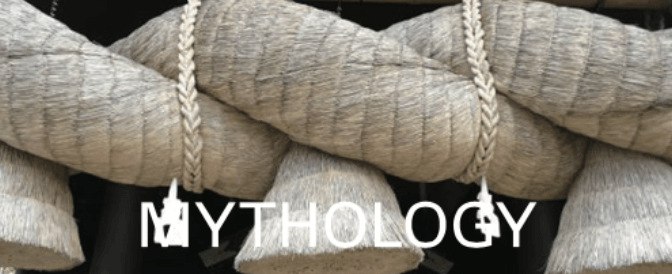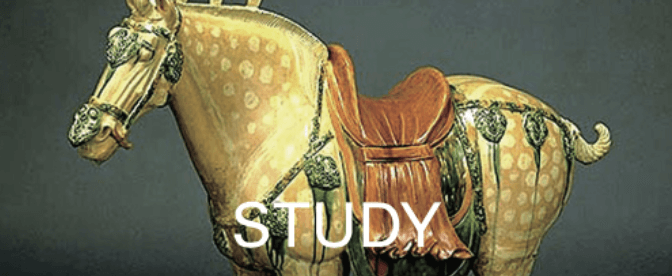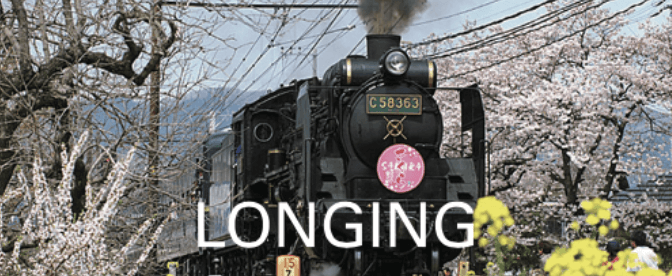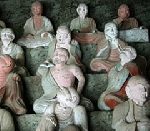
The colored statues of 500 Rakan, disciples of the Buddha, are memorial statues for people who passed away in the Iwami Silver Mine during the Edo period (1603 – 1868). Those and three arched bridges were made for a span of 25 years by Tsubouchi Heihichi (1767 – 1798), a Japanese mason at Fukumitsu, Yunotsucho, Shimane, and his son with his disciples.
Rakan is in between the Buddha and the people. Those arched bridges were made of local Fukumitsu-ishi, tuff, which is a pale blue-green, and had been deposited on the sea floor for ages (15 – 16 millions years ago) . Fukumitsu-ishi supports and accompanies the eternal journey of the soul.
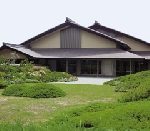
This museum also exhibits precious boyhood paintings, sketches, rough-sketches, and other late-life works of Hirayama Ikuo (1930 – 2009). Hirayama was bombed on August 6, 1945. After suffering from an aftereffect of an atomic bomb, he draws many works that hope for peace, including “Transmission of Buddhism”.
In search of the origin of Buddhism, he traveled to the Silk Road. That distance reached 350,000 km. Travel makes history and traveling makes people.
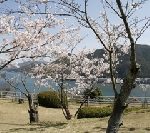
Ushimado, Setouchi City had been a port for awaiting a favorable tide and wind, since ancient times. The name of this place, Ushimado, was derived from Ushioni (a cow demon orally handed down in western Japan), that was thrown by Sumiyoshi Myojin, a guardian of safe sea travel, Waka (Japanese poem), and agriculture and fishing.
Okayama domaine hosted Chosen Tsushinshi, Envoys from Korea for Peace Building and Cultural Exchanges between Korea and Japan from the 17th to 19th century, here in the Edo period (1603 – 1868).
And the sunset in this town was selected as one of the top 100 sunsets in Japan. Kaikei, who was a sculptor of Buddha statues of the Kei school, during the Kamakura period (1185 – 1333), made the statue of Amida Buddha: the principal image of Buddha in Pure Land, as it was calculated so that the sunset would overlap.
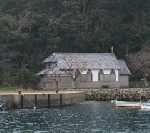
Former Gorin Church in Hisakajima Island of Goto Islands, is the second-oldest wooden church in Nagasaki prefecture (after National Treasure Ouratenshu-do, Oura church). It is located opposite the boat harbor at the fishing port.
This building has pantile roofing and a roof board with thin round bamboo. The arched ceiling in the sacred place is divided with eight partition boards. The gentle pointed arch is also provided at the top of the colonnade, to ensure continuity between the arched ceiling in the main corridor and the side corridor.
It is a precious style from the beginning of the Meiji period (1868 – 1912)
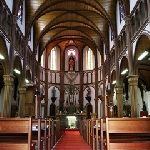
The Romanesque style Totenshu-do (Church) is in Kuroshima Sasebo. Christians escaped here from persecution during the Edo period (1603 – 1868).
A French priest established the National Treasure Ouratenshu-do, Oura church, in the end of the Edo period. Descendants of the underground Christians secretly visited them from Kuroshima.
Like Arita ware, the decoration on the floor of the church has not faded for over 100 years. Kuroshima has inherited this belief.
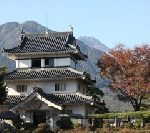
In 1633, Japanese Father Juliao Nakaura (1568 – 1633), a member of the Tensho Embassy to the Pope and the kings of Europe in 1582, was a martyr of Nagasaki. He was relegated to underground activities for 20 years by feudal Christian Japanese lords. As a result, Japanese Christians lost their professional religious leader.
In 1637, the Shimabara Rebellion (1637 – 1638) was in fact a riot against the coercion of Matsukura Katsuie (1597 – 1638), the 2nd feudal lord of the Shimabara domain, and his son, after the summer campaign of the siege of Osaka in 1615.
The shining, white 5-story castle tower of Shimabarajo Castle displays historical materials. Maria Kannon, statutes of the Virgin Mary disguised as a Buddhist Kannon: the Buddhist Goddess of Mercy, used by hidden Christians during the Edo period (1603 – 1868), are exhibited. Those statues were used to keep the light of faith even without a leader.
It represents the beauty from a single-minded person under irrational situations.

Father Juliao Nakaura (1568 – 1633), a member of the Tensho Embassy to the Pope and the kings of Europe in 1582, was delegated by Christianized feudal Japanese lords. He said “I will be with those who give themselves into all possible persecutions due to their religion.” in a letter to an old friend in Rome in 1621. That letter is introduced at this museum.
The decree for purging missionaries was published before he returned to Japan in 1587, by Toyotomi Hideyoshi (1537 – 1598), the powerful feudal lord and Imperial Regent who unified Japan. The decree of prohibition on Christianity was published in 1614 by Tokugawa Ieyasu (1543 – 1616), the founder of the Tokugawa Shogunate.
Father Juliao Nakaura, who continued underground activities for 20 years, was martyred in Nagasaki, in 1633.
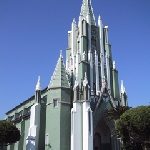
The best view in Hirado is the moss green outer wall, several white spires, and the cross of this church, along with the Buddhist temple.
This church facing the port of Hirado, commemorates the year of 1550, when Franciso de Xavier (1506 – 1552), co-founder of the Society of Jesus and the first Christian missionary to venture into Japan, landed from Kagoshima on a Portuguese merchant ship.
The rib vault ceiling with white stucco-finish, flying buttresses, and crimson carpets inside church, convey a new will to live.
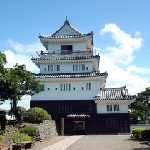
This castle facing the East China Sea was built by Matsuura Takashi (1646 – 1713), a feudal lord, the fifth lord of the Hirato Domain, in 1707. This castle was the only castle on a hill in the plains in Japan. Its basic layout was designed by Yamagaryu, Yamaga school military science.
The Matsuura clan, which was the feudal lord of this castle, used to be a marine force, with an active role in Matsuura Hizen province, Saga from the Heian period to the Sengoku period, the 9th -16th centuries.
National important cultural properties, like a sword with Head Ornaments, materials and armors of Matsuura Domain, materials of an underground Christian, and others. are exhibited inside the castle tower.

In 1637, the Shimabara Rebellion (1637 – 1638) occurred in Shimabara Nagasaki, after the martyrdom of the last religious leader, Father Juliao Nakaura (1568 – 1633). Nakaura was a member of the Tensho Embassy to the Pope and the kings of Europe in 1582, delegated by Christianised feudal Japanese lords.
It was the largest Christian Ikki, uprising, in Japanese history. Amakusa Shiro, who is said to be the leader, was born in Amakusa and was 16 years old at that time. It is unknown whether Shiro had already received a priesthood education, prior to leading the rebellion.
Overlooking Shimabara, on the other side of this coast and Shiro’s pure mind, you can see the crystal-clear waters, from the observatory, and the sunset over the horizon of the Amakusa-nada Sea.
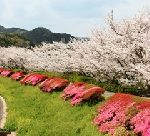
Kawaura Town has been a political and cultural center of Amakusa since old times. Amakusa Collezillo, a priest training school, was built in 1597, 42 years after Franciso de Xavier’s (1506 – 1552) arrival to Japan. He was the co-founder of the Society of Jesus and the first Christian missionary to venture into Japan, for 7 years.
29 types of Amakusa-hon, books printed by a western printing machine, were published by a Letterpress printing machine, which was brought here by the Tensho Embassy to the Pope and the kings of Europe in 1582. The Nanban culture, the European Culture, flourished here.
This park is presumed to be the site of Amakusa Collezio, and is a famous cherry blossom spot from the old days, where promenades and resting places are maintained.
